人工智能练习题
- 格式:doc
- 大小:451.50 KB
- 文档页数:24
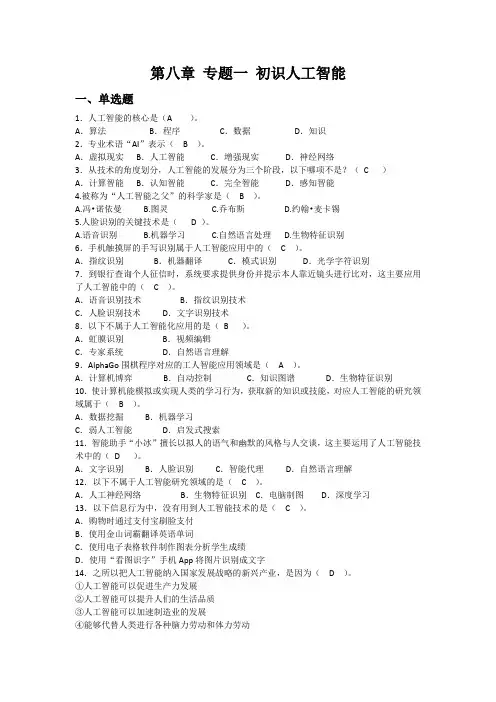
第八章专题一初识人工智能一、单选题1.人工智能的核心是(A)。
A.算法B.程序C.数据D.知识2.专业术语“AI”表示( B )。
A.虚拟现实B.人工智能C.增强现实D.神经网络3.从技术的角度划分,人工智能的发展分为三个阶段,以下哪项不是?(C )A.计算智能B.认知智能C.完全智能D.感知智能4.被称为“人工智能之父”的科学家是( B )。
A.冯•诺依曼B.图灵C.乔布斯D.约翰•麦卡锡5.人脸识别的关键技术是( D )。
A.语音识别B.机器学习C.自然语言处理D.生物特征识别6.手机触摸屏的手写识别属于人工智能应用中的( C )。
A.指纹识别B.机器翻译C.模式识别D.光学字符识别7.到银行查询个人征信时,系统要求提供身份并提示本人靠近镜头进行比对,这主要应用了人工智能中的( C )。
A.语音识别技术B.指纹识别技术C.人脸识别技术D.文字识别技术8.以下不属于人工智能化应用的是(B )。
A.虹膜识别B.视频编辑C.专家系统D.自然语言理解9.AlphaGo围棋程序对应的工人智能应用领域是( A )。
A.计算机博弈B.自动控制C.知识图谱D.生物特征识别10.使计算机能模拟或实现人类的学习行为,获取新的知识或技能,对应人工智能的研究领域属于(B)。
A.数据挖掘B.机器学习C.弱人工智能D.启发式搜索11.智能助手“小冰”擅长以拟人的语气和幽默的风格与人交谈,这主要运用了人工智能技术中的(D )。
A.文字识别B.人脸识别C.智能代理D.自然语言理解12.以下不属于人工智能研究领域的是( C )。
A.人工神经网络B.生物特征识别C.电脑制图D.深度学习13.以下信息行为中,没有用到人工智能技术的是( C )。
A.购物时通过支付宝刷脸支付B.使用金山词霸翻译英语单词C.使用电子表格软件制作图表分析学生成绩D.使用“看图识字”手机App将图片识别成文字14.之所以把人工智能纳入国家发展战略的新兴产业,是因为( D )。
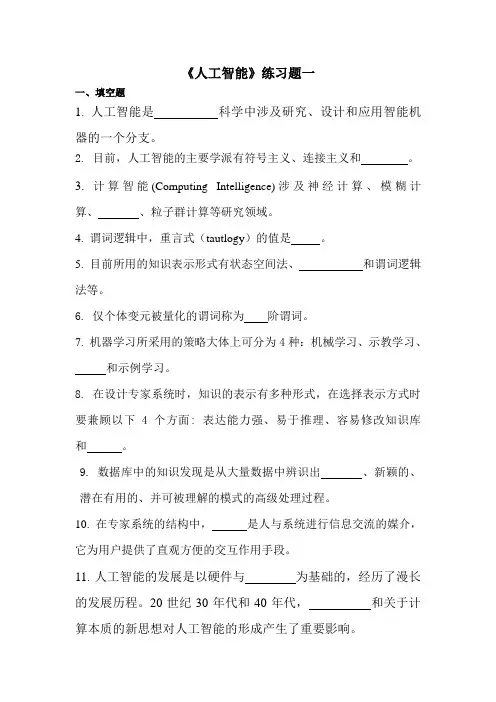
《人工智能》练习题一一、填空题1. 人工智能是科学中涉及研究、设计和应用智能机器的一个分支。
2. 目前,人工智能的主要学派有符号主义、连接主义和。
3.计算智能(Computing Intelligence)涉及神经计算、模糊计算、、粒子群计算等研究领域。
4. 谓词逻辑中,重言式(tautlogy)的值是。
5.目前所用的知识表示形式有状态空间法、和谓词逻辑法等。
6.仅个体变元被量化的谓词称为阶谓词。
7.机器学习所采用的策略大体上可分为4种:机械学习、示教学习、和示例学习。
8. 在设计专家系统时,知识的表示有多种形式,在选择表示方式时要兼顾以下4个方面: 表达能力强、易于推理、容易修改知识库和。
9. 数据库中的知识发现是从大量数据中辨识出、新颖的、潜在有用的、并可被理解的模式的高级处理过程。
10. 在专家系统的结构中,是人与系统进行信息交流的媒介,它为用户提供了直观方便的交互作用手段。
11.人工智能的发展是以硬件与为基础的,经历了漫长的发展历程。
20世纪30年代和40年代,和关于计算本质的新思想对人工智能的形成产生了重要影响。
12. 符号主义认为人的认知基元是,而且认知过程即为符号操作过程。
13.在谓词公式中,紧接于量词之后被量词作用的谓词公式称为该量词的,而在一个量词的辖域中与该量词的指导变元相同的变元称为约束变元,其他变元称为自由变元。
14.目前所用的知识表示形式有状态空间、问题归约法和等。
15.在与或图中,没有后裔的非终叶节点为不可解节点,那么含有或后继节点且后裔中至少有一个为可解的非终叶节点是节点,含有与后继节点且后裔中至少有一个为不可解的非终叶节点是不可解节点。
16. 机器学习所采用的策略大体上可分为4种:机械学习、示教学习、类比学习和。
17.学习就是记忆,即把新的知识存储起来,供需要时检索调用,而不需要计算和推理。
18. 数据库中的知识发现是从大量数据中辨识出有效的、、潜在有用的、并可被理解的模式的高级处理过程。
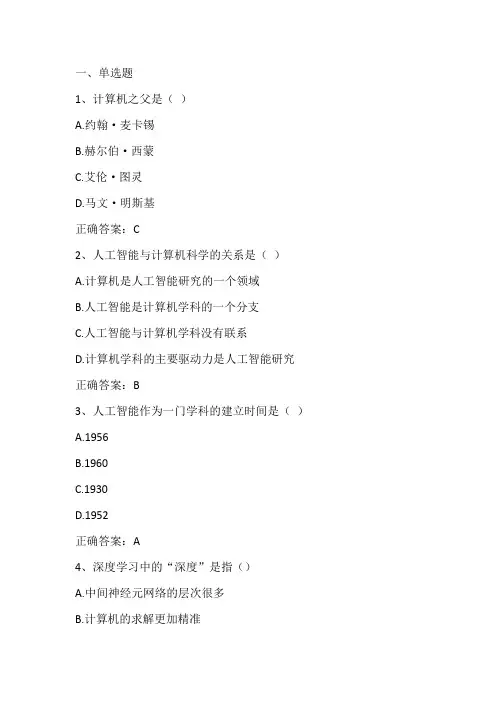
一、单选题1、计算机之父是()A.约翰·麦卡锡B.赫尔伯·西蒙C.艾伦·图灵D.马文·明斯基正确答案:C2、人工智能与计算机科学的关系是()A.计算机是人工智能研究的一个领域B.人工智能是计算机学科的一个分支C.人工智能与计算机学科没有联系D.计算机学科的主要驱动力是人工智能研究正确答案:B3、人工智能作为一门学科的建立时间是()A.1956B.1960C.1930D.1952正确答案:A4、深度学习中的“深度”是指()A.中间神经元网络的层次很多B.计算机的求解更加精准C.计算机理解的深度D.计算机对问题的处理更加灵活正确答案:A5、深度学习的实质是()A.推理机制B.模拟机制C.映射机制D.识别机制正确答案:C6、一个真正的通用人工智能系统应具备处理()问题的能力A.局部性B.全局性C.统一性D.专业性正确答案:B7、如何推进人工智能的研究()A.提升计算机处理数据的能力B.研发通用人工智能C.继续完善深度学习D.研究人类自己的智能正确答案:D8、大数据的样本空间是()A.针对所有相关数据B.以上都不对C.需要确立样本范围D.不做样本控制正确答案:D9、深度学习的数据资料来源于()A.抽样调查B.人工搜集C.互联网D.已经有数据库正确答案:C10、过度开采社会人文资源,是指在大数据的环境下对()的侵犯A.个人隐私B.大众的消费习惯C.大众心理D.个人的行为习惯正确答案:A11、在人工智能的所有子课题中,所牵涉范围最广的是()A.自然语言处理B.机器视觉C.非确定条件下的推理D.机器听觉正确答案:A12、SHRDLU系统实际上是一个()A.人工装置B.语义模型C.人工神经元网络D.积木系统正确答案:D13、可以用来界定因果关系的是()A.贝叶斯公式B.后验概率C.归纳逻辑D.先验概率正确答案:B14、()思想激发了基于中间语的机器翻译思路。
A.塞尔B.笛卡尔C.康德D.莱布尼茨正确答案:D15、磨坊论证出自()A.《人类理智新论》B.《神正论》C.《单子论》D.《纯粹理性批判》正确答案:C二、多选题1、技术背后还有着()问题A.社会的公平正义B.健康的上网习惯C.如何取样D.社会的价值导向正确答案:A、D2、绿色人工智能是指A.消耗资源少B.对环境友好C.效率高D.所需数据小正确答案:A、B、D3、下列属于行为主义心理学家的是()A.巴浦洛夫B.博尔赫斯·斯金纳C.冯特D.约翰·华生正确答案:B、D4、乔姆斯基认为人类的语法有哪两个层面()A.句法层面B.浅层语法C.语义层面D.深层语法正确答案:B、D5、康德认为知识的来源有哪两部分()A.心之自发性B.先天范畴C.感性材料D.感官的杂多性正确答案:A、D6、对人工智能常见的误解有哪些A.人工智能就是深度学习B.人工智能最近十年受到深度学习的驱动较多C.人工智能就是机器学习D.机器学习只是人工智能中的一个方向正确答案:A、C7、下列哪些选项是符号AI的技术路线()A.贝叶斯网络B.机器学习C.深度学习D.通用问题求解器正确答案:A、D8、符号AI的问题在于()A.缺少推理必要的信息B.缺少推理的灵活性C.会遭遇“框架问题”D.把推理所依赖的公理系统全部锁死正确答案:B、C、D9、人工神经元网络的运作分为()A.输入层B.中间处理层C.输出层D.映射机制正确答案:A、B、C10、下列哪些选项属于通用智力因素()A.流体智力B.晶体智力C.反应速度D.短期记忆正确答案:A、B、C、D三、判断题1、类脑人工智能是指模拟人类大脑的人工智能2、智能与神经元网络的存在具有必然关系正确答案:×3、由于大数据只能体现出数量而不能进行质量上的判断,所以在采样并不完整的情况下给出的结论未必准确。
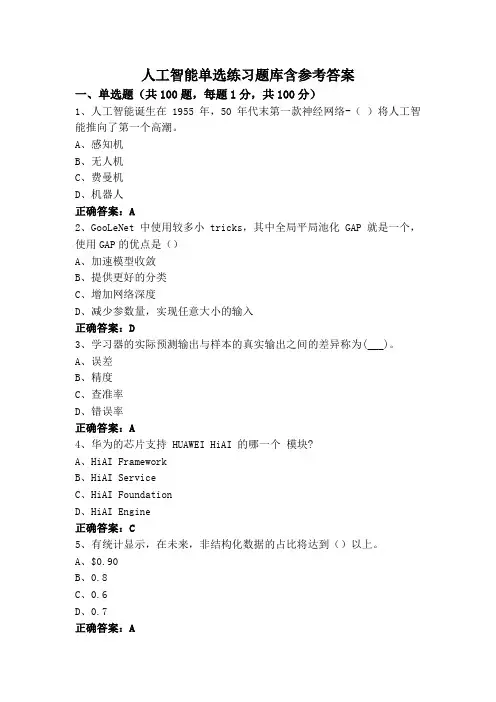
人工智能单选练习题库含参考答案一、单选题(共100题,每题1分,共100分)1、人工智能诞生在1955年,50年代末第一款神经网络-()将人工智能推向了第一个高潮。
A、感知机B、无人机C、费曼机D、机器人正确答案:A2、GooLeNet中使用较多小tricks,其中全局平局池化GAP就是一个,使用GAP的优点是()A、加速模型收敛B、提供更好的分类C、增加网络深度D、减少参数量,实现任意大小的输入正确答案:D3、学习器的实际预测输出与样本的真实输出之间的差异称为(___)。
A、误差B、精度C、查准率D、错误率正确答案:A4、华为的芯片支持 HUAWEI HiAI 的哪一个模块?A、HiAI FrameworkB、HiAI ServiceC、HiAI FoundationD、HiAI Engine正确答案:C5、有统计显示,在未来,非结构化数据的占比将达到()以上。
A、$0.90B、0.8C、0.6D、0.7正确答案:A6、我国人工智能的发展战略是()。
A、12320工业互联B、“1438”战略C、新一代人工智能发展规划D、国家制造创新正确答案:C7、()就是指分类任务中不同类别的训练样例数目差别很大的情况A、类别不相同B、类别不对等C、类别不平衡D、类别数不同正确答案:C8、以下哪个关键字是与 try 语句一起使用来处理异常的?A、&catch(a)&B、catch&C、&exception&D、&except正确答案:D9、深度学习中的“深度”是指()A、计算机对问题的处理更加灵活B、中间神经元网络的层次很多C、计算机的求解更加精准D、计算机理解的深度正确答案:B10、增强现实领域(AR)大量应用了(),典型的就是微软的HoLolens。
A、计算机视觉B、语音识别C、图像处理D、虚拟现实技术正确答案:A11、DBSCAN在最坏情况下的时间复杂度是()A、O(m2)B、O(m*logm)C、O(logm)D、O(m)正确答案:A12、多义现象可以被定义为在文本对象中一个单词或短语的多种含义共存。
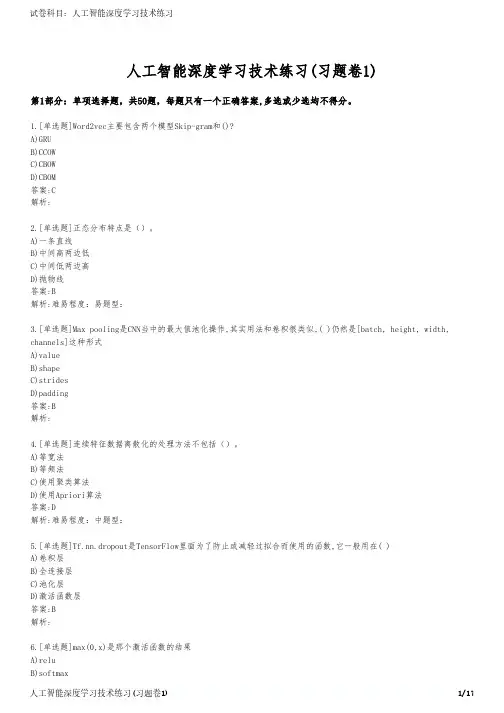
人工智能深度学习技术练习(习题卷1)第1部分:单项选择题,共50题,每题只有一个正确答案,多选或少选均不得分。
1.[单选题]Word2vec主要包含两个模型Skip-gram和()?A)GRUB)CCOWC)CBOWD)CBOM答案:C解析:2.[单选题]正态分布特点是()。
A)一条直线B)中间高两边低C)中间低两边高D)抛物线答案:B解析:难易程度:易题型:3.[单选题]Max pooling是CNN当中的最大值池化操作,其实用法和卷积很类似,( )仍然是[batch, height, width, channels]这种形式A)valueB)shapeC)stridesD)padding答案:B解析:4.[单选题]连续特征数据离散化的处理方法不包括()。
A)等宽法B)等频法C)使用聚类算法D)使用Apriori算法答案:D解析:难易程度:中题型:5.[单选题]Tf.nn.dropout是TensorFlow里面为了防止或减轻过拟合而使用的函数,它一般用在( )A)卷积层B)全连接层C)池化层D)激活函数层答案:B解析:D)leaky-relu答案:A解析:7.[单选题]Hinton和Bengio、Yann.lecun等提成了一个实际可行的( )框架A)MLB)deep learningC)opencvD)TF答案:B解析:8.[单选题]下列哪一项在 神经网络中引入了非线性?( )A)随机梯度下降B)修正线性单元(ReLU)C)卷积函数D)以上都不正确答案:B解析:9.[单选题]提出“人工智能”概念是在()年A)1955B)1956C)1957D)1958答案:B解析:10.[单选题]CNN卷积神经网络,RNN循环神经网络,( )这三个网络都是TensorFlow中支持并常用的经典网络A)RNNB)XNNC)BNND)LSTM长短记忆算法答案:D解析:11.[单选题]在AlexNet 等典型的卷积神经网络中,随着网络的深度增加,通常有( )A)每层的通道的高度和宽度减少,通道数增加。
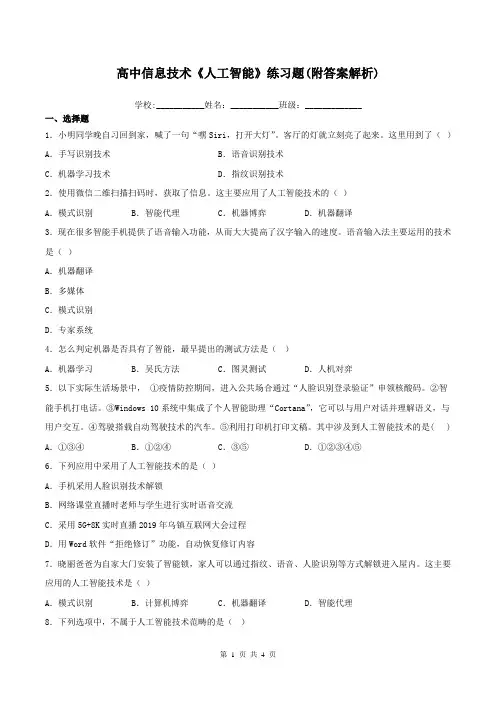
高中信息技术《人工智能》练习题(附答案解析)学校:___________姓名:___________班级:_____________一、选择题1.小明同学晚自习回到家,喊了一句“嘿Siri,打开大灯”。
客厅的灯就立刻亮了起来。
这里用到了()A.手写识别技术B.语音识别技术C.机器学习技术D.指纹识别技术2.使用微信二维扫描扫码时,获取了信息。
这主要应用了人工智能技术的()A.模式识别B.智能代理C.机器博弈D.机器翻译3.现在很多智能手机提供了语音输入功能,从而大大提高了汉字输入的速度。
语音输入法主要运用的技术是()A.机器翻译B.多媒体C.模式识别D.专家系统4.怎么判定机器是否具有了智能,最早提出的测试方法是()A.机器学习B.吴氏方法C.图灵测试D.人机对弈5.以下实际生活场景中,①疫情防控期间,进入公共场合通过“人脸识别登录验证”申领核酸码。
②智能手机打电话。
③Windows 10系统中集成了个人智能助理“Cortana”,它可以与用户对话并理解语义,与用户交互。
④驾驶搭载自动驾驶技术的汽车。
⑤利用打印机打印文稿。
其中涉及到人工智能技术的是() A.①③④B.①②④C.③⑤D.①②③④⑤6.下列应用中采用了人工智能技术的是()A.手机采用人脸识别技术解锁B.网络课堂直播时老师与学生进行实时语音交流C.采用5G+8K实时直播2019年乌镇互联网大会过程D.用Word软件“拒绝修订”功能,自动恢复修订内容7.晓丽爸爸为自家大门安装了智能锁,家人可以通过指纹、语音、人脸识别等方式解锁进入屋内。
这主要应用的人工智能技术是()A.模式识别B.计算机博弈C.机器翻译D.智能代理8.下列选项中,不属于人工智能技术范畴的是()A.手机的人脸识别解锁技术B.使用在线翻译技术,将场景中的日文翻译成中文C.与好友在微信中视频聊天D.AlphaGo击败世界围棋冠军李世石9.下列关于图灵测试说法错误的是()A.图灵测试是测试机器是否具有智能唯一的方法B.图灵测试会在测试人在与被测试者(一个人和一台机器)隔开的情况下,通过此装置(如键盘)向被测试者随意提问,测试者根据问答判断被测试者是人还是机器C.图灵测试由“现代计算机理论之父”图灵提出D.通过问答的方式能通过图灵测试,不代表这个机器能具备像人一样的心智10.下列不属于...人工智能技术应用范畴的是A.使用OCR软件识别文字B.汉字语音输入系统C.使用文字翻译软件翻译外文D.与同学下棋11.AI的英文缩写是()A.Artificial Intelligence B.Automatic IntelligenceC.Automatic Information D.Artificial Information二、填空题12.机器学习的一般过程为:用采集到的数据进行训练,以建立一个模型,再对模型进行( ),然后投入应用。
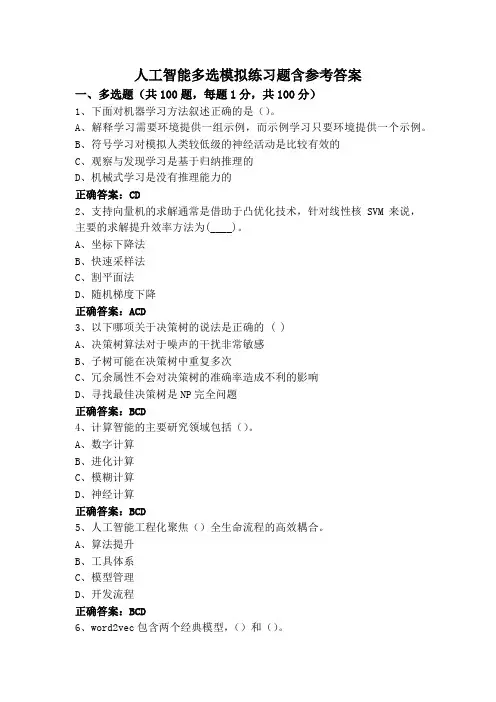
人工智能多选模拟练习题含参考答案一、多选题(共100题,每题1分,共100分)1、下面对机器学习方法叙述正确的是()。
A、解释学习需要环境提供一组示例,而示例学习只要环境提供一个示例。
B、符号学习对模拟人类较低级的神经活动是比较有效的C、观察与发现学习是基于归纳推理的D、机械式学习是没有推理能力的正确答案:CD2、支持向量机的求解通常是借助于凸优化技术,针对线性核SVM来说,主要的求解提升效率方法为(____)。
A、坐标下降法B、快速采样法C、割平面法D、随机梯度下降正确答案:ACD3、以下哪项关于决策树的说法是正确的 ( )A、决策树算法对于噪声的干扰非常敏感B、子树可能在决策树中重复多次C、冗余属性不会对决策树的准确率造成不利的影响D、寻找最佳决策树是NP完全问题正确答案:BCD4、计算智能的主要研究领域包括()。
A、数字计算B、进化计算C、模糊计算D、神经计算正确答案:BCD5、人工智能工程化聚焦()全生命流程的高效耦合。
A、算法提升B、工具体系C、模型管理D、开发流程正确答案:BCD6、word2vec包含两个经典模型,()和()。
A、Skip-gramB、Skip-cramC、CBOWD、BCOW正确答案:AC7、对于FPGA描述正确的是()A、FPGA内部是一种与或阵列结构。
B、FPGA在断电后信息不会丢失。
C、FPGA是现场可编程门阵列的简称。
D、FPGA属于高密度可编程逻辑器件。
正确答案:CD8、函数能处理比定义时更多的参数,他们是()参数。
A、不可变B、收集C、不定长D、可变正确答案:BCD9、关于python的字符串,下列说法正确的是A、在三引号字符串中可以包含换行回车等特殊字符B、字符串以\0标志字符串的结束C、既可以用单引号,也可以用双引号创建字符串D、字符应该视为长度为1的字符串正确答案:ACD10、下列()是有序的。
A、集合B、列表C、字符串D、元组正确答案:BCD11、以下哪些是常见的神经网络()?A、SQM网络B、ART网络C、RIO网络D、RBF网络E、SOM网络正确答案:BDE12、常见的聚类技术有()A、KonhonennetworkB、两步聚类C、K平均值聚类D、分层聚类正确答案:ABCD13、DSSM模型总的来说可以分成三层结构,分别是()A、表示层B、输出层C、匹配层D、输入层正确答案:ACD14、机器学习的要素有哪些?A、泛化能力B、样本空间划分C、一致性假设正确答案:ABC15、关于Python的全局变量和局部变量,以下选项中描述正确的是A、使用global保留字声明简单数据类型变量后,该变量作为全局变量使用B、全局变量指在函数之外定义的变量,一般没有缩进,在程序执行全过程有效C、简单数据类型变量无论是否与全局变量重名,仅在函数内部创建和使用,函数退出后变量被释放D、局部变量指在函数内部使用的变量,当函数退出时,变量依然存在,下次函数调用可以继续使用正确答案:ABC16、以下属于机器学习的是()A、监督式学习B、强化学习C、非监督式学习D、半监督式学习正确答案:ABCD17、“噪声”是指测量变量中的随机错误或偏差,噪声数据的主要表现形式有哪些?A、错误数据B、缺失数据C、异常数据D、虚假数据正确答案:ACD18、知识图谱的垂直领域应用包括( )。
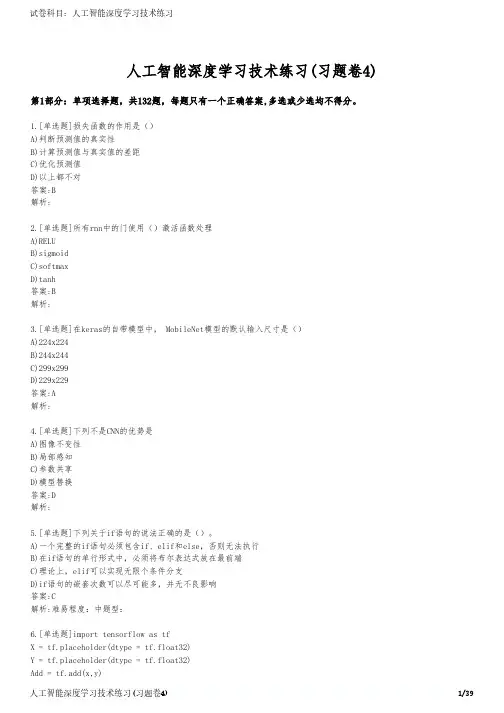
人工智能深度学习技术练习(习题卷4)第1部分:单项选择题,共132题,每题只有一个正确答案,多选或少选均不得分。
1.[单选题]损失函数的作用是()A)判断预测值的真实性B)计算预测值与真实值的差距C)优化预测值D)以上都不对答案:B解析:2.[单选题]所有rnn中的门使用()激活函数处理A)RELUB)sigmoidC)softmaxD)tanh答案:B解析:3.[单选题]在keras的自带模型中, MobileNet模型的默认输入尺寸是()A)224x224B)244x244C)299x299D)229x229答案:A解析:4.[单选题]下列不是CNN的优势是A)图像不变性B)局部感知C)参数共享D)模型替换答案:D解析:5.[单选题]下列关于if语句的说法正确的是()。
A)一个完整的if语句必须包含if、elif和else,否则无法执行B)在if语句的单行形式中,必须将布尔表达式放在最前端C)理论上,elif可以实现无限个条件分支D)if语句的嵌套次数可以尽可能多,并无不良影响答案:C解析:难易程度:中题型:6.[单选题]import tensorflow as tfX = tf.placeholder(dtype = tf.float32)Y = tf.placeholder(dtype = tf.float32)Add = tf.add(x,y)With tf.Session() as sess:Sess.run(tf.global_variables_initializer())Print(sess.run(add,feed_dict = {x:3,y:8}))该程序运行的输出结果为A)3.0B)8.0C)11.0D)5.0答案:C解析:7.[单选题]假设一个具有 3个神经元和输入为「1.2.3]的简单 MLP模型。
输入神经元的权重分别为 4,5 和 6。
假设激活函数是一个线性常数值 3(激活函数为:y=3x)。
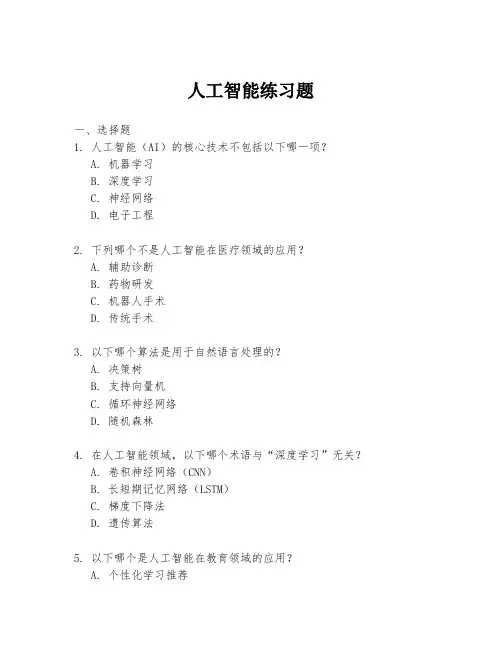
人工智能练习题一、选择题1. 人工智能(AI)的核心技术不包括以下哪一项?A. 机器学习B. 深度学习C. 神经网络D. 电子工程2. 下列哪个不是人工智能在医疗领域的应用?A. 辅助诊断B. 药物研发C. 机器人手术D. 传统手术3. 以下哪个算法是用于自然语言处理的?A. 决策树B. 支持向量机C. 循环神经网络D. 随机森林4. 在人工智能领域,以下哪个术语与“深度学习”无关?A. 卷积神经网络(CNN)B. 长短期记忆网络(LSTM)C. 梯度下降法D. 遗传算法5. 以下哪个是人工智能在教育领域的应用?A. 个性化学习推荐B. 标准化考试C. 传统课堂讲授D. 纸质教材二、填空题6. 人工智能的三大支柱是________、________和________。
7. 人工智能的发展历程中,________年被称为人工智能的元年。
8. 人工智能在图像识别领域常用的一种算法是________。
9. 人工智能在金融领域可以应用于________、________等。
10. 人工智能在自动驾驶技术中,主要应用了________和________等技术。
三、简答题11. 简述人工智能与机器学习之间的关系。
12. 描述一下人工智能在智能家居领域的应用场景。
13. 解释什么是强化学习,并给出一个实际应用的例子。
14. 阐述人工智能在提高生产效率方面的潜在作用。
15. 讨论人工智能在伦理和隐私方面可能面临的挑战。
四、论述题16. 论述人工智能在未来发展中的潜在影响,包括对社会、经济和文化的影响。
17. 分析人工智能在教育个性化推荐系统中的优势和局限性。
18. 讨论人工智能在医疗诊断中的作用及其对医疗行业的影响。
19. 描述人工智能在艺术创作中的应用,并探讨其对艺术领域的影响。
20. 论述人工智能在环境监测和保护中的应用及其重要性。
五、案例分析题21. 阅读以下案例:某公司开发了一款智能客服机器人,用于在线解答用户咨询。
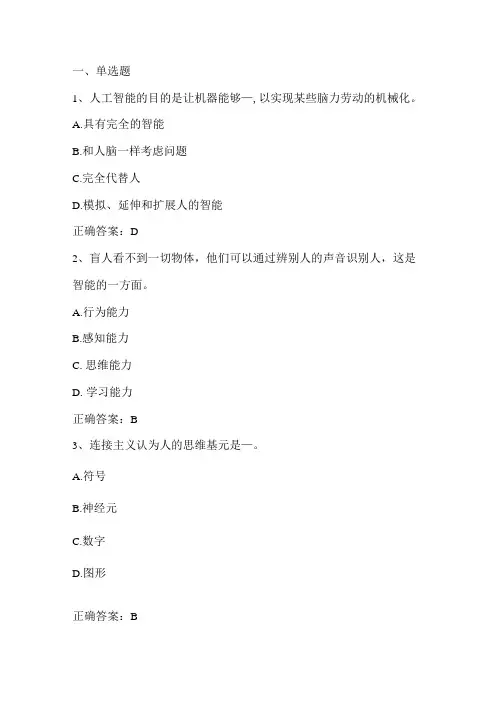
一、单选题1、人工智能的目的是让机器能够—,以实现某些脑力劳动的机械化。
A.具有完全的智能B.和人脑一样考虑问题C.完全代替人D.模拟、延伸和扩展人的智能正确答案:D2、盲人看不到一切物体,他们可以通过辨别人的声音识别人,这是智能的一方面。
A.行为能力B.感知能力C.思维能力D.学习能力正确答案:B3、连接主义认为人的思维基元是—。
A.符号B.神经元C.数字D.图形正确答案:B4、第一个神经元的数学模型-MP模型是年诞生的。
A.1943B.1958C.1982D.1986正确答案:A5、符号主义认为人工智能源于—oA.数理逻辑B.神经网络C.信息检索D.遗传算法正确答案:A6、被誉为“人工智能之父”的科学家是—oA.明斯基B.麦卡锡C.图灵D.香农正确答案:C7、在等代价搜索算法中,总是选择—节点进行扩展。
A.代价最小B.深度最小C.深度最大D.代价最大正确答案:A8、八数码问题中,启发函数f(x)=g(x)+h(x)中的常使用—来定义g(x)OA.节点X与目标状态位置不同的棋子个数B.节点X的子节点数C.节点X与目标状态位置相同的棋子个数D.节点X所在层数正确答案:D9、在图搜索算法中,设规定每次优先从OPEN表的前端取一个节点进行考察,则在宽度优先搜索中,新扩展出的子代节点应该放在OPEN表的OA.前端B.末端C.任意位置D.后端正确答案:B10、在图搜索算法中,设规定每次优先从OPEN表的前端取一个节点进行考察,则在深度优先搜索中,新扩展出的子代节点应该放在OPEN表的OA.前端B.末端C.任意位置D.后端正确答案:A11、如果问题存在最优解,则下面几种搜索算法中,—必然可以得到该最优解。
A.宽度优先搜索B.深度优先搜索C.有界深度优先搜索D.A*算法正确答案:A12、在启发式搜索中,—提供一个评定侯选扩展节点的方法,以便确定哪个节点最有可能在通向目标的最佳路径上。
A.估价函数B.最优函数C.测试函数D.区间函数正确答案:A13、已知初始问题的描述,通过一系列变换把此问题最终变为一个子问题集合;这些子问题的解可以直接得到,从而解决了初始问题。
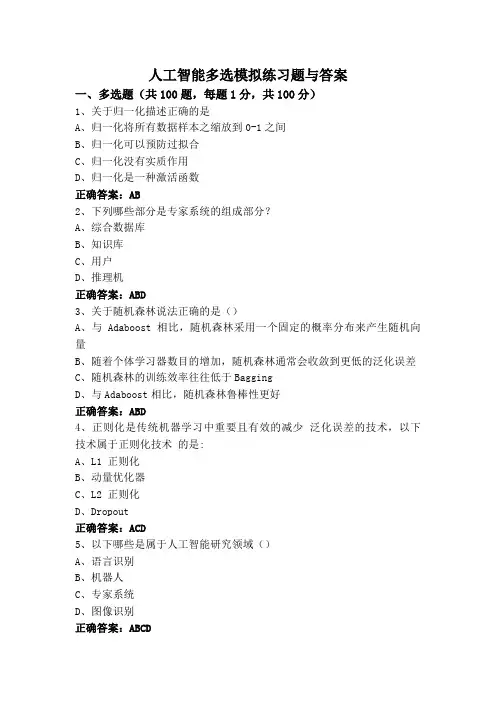
人工智能多选模拟练习题与答案一、多选题(共100题,每题1分,共100分)1、关于归一化描述正确的是A、归一化将所有数据样本之缩放到0-1之间B、归一化可以预防过拟合C、归一化没有实质作用D、归一化是一种激活函数正确答案:AB2、下列哪些部分是专家系统的组成部分?A、综合数据库B、知识库C、用户D、推理机正确答案:ABD3、关于随机森林说法正确的是()A、与Adaboost相比,随机森林采用一个固定的概率分布来产生随机向量B、随着个体学习器数目的增加,随机森林通常会收敛到更低的泛化误差C、随机森林的训练效率往往低于BaggingD、与Adaboost相比,随机森林鲁棒性更好正确答案:ABD4、正则化是传统机器学习中重要且有效的减少泛化误差的技术,以下技术属于正则化技术的是:A、L1 正则化B、动量优化器C、L2 正则化D、Dropout正确答案:ACD5、以下哪些是属于人工智能研究领域()A、语言识别B、机器人C、专家系统D、图像识别正确答案:ABCD6、统计学习的主要特点包括()。
A、统计学习以计算机及网络为平台,是建立在计算机及网络之上的B、统计学习以方法为中心,统计学习方法构建模型并应用模型进行预测与分析C、统计学习的目的是对数据进行预测与分析D、统计学习以模型为研究对象,是算法驱动的学科正确答案:ABC7、以下方法不需要目标向量的是()A、监督学习B、特征选择嵌入法C、无监督学习D、特征选择过滤法正确答案:CD8、计算机系统中运行在硬件之上的一层是操作系统 OS,它控制和管理着系统硬件,操作系统的功能主要有()。
A、存储管理B、文件管理C、进程管理D、设备管理正确答案:ABCD9、数据的基本属性包括A、数值属性B、标称属性C、字符串属性D、二元属性正确答案:ABD10、常用的数据审计方法有()。
A、可视化审计B、自定义审计C、结构化审计D、预定义审计正确答案:ABD11、在计算机视觉应用中,常用的图像特征有()。
人工智能练习题一、选择题1. 人工智能(AI)的核心技术包括以下哪项?A. 大数据分析B. 机器学习C. 神经网络D. 所有选项2. 以下哪个不是人工智能的应用领域?A. 医疗诊断B. 语言翻译C. 植物种植D. 自动驾驶3. 深度学习是人工智能的一个子领域,它主要基于以下哪种模型?A. 决策树B. 支持向量机C. 神经网络D. 随机森林4. 以下哪个算法不是用于聚类分析的?A. K-meansB. 层次聚类C. 逻辑回归D. DBSCAN5. 在机器学习中,过拟合是指模型:A. 训练数据拟合不足B. 训练数据拟合过度C. 测试数据拟合不足D. 测试数据拟合过度二、填空题6. 人工智能的英文缩写是________。
7. 机器学习中的监督学习需要________数据集。
8. 人工智能中的自然语言处理(NLP)主要处理的是________。
9. 在神经网络中,激活函数的作用是________。
10. 强化学习是一种让智能体通过________来学习最优策略的方法。
三、简答题11. 请简述人工智能与机器学习的关系。
12. 描述一下什么是卷积神经网络(CNN)以及它在图像识别中的应用。
13. 解释什么是生成对抗网络(GAN)以及它在艺术创作中的应用。
14. 举例说明人工智能在日常生活中的一个应用场景。
15. 阐述一下人工智能在医疗领域的潜在影响。
四、论述题16. 论述人工智能在教育领域的应用及其可能带来的变革。
17. 讨论人工智能在伦理和隐私方面面临的挑战。
18. 分析人工智能对就业市场的影响及其可能的解决方案。
五、案例分析题19. 假设你是一名人工智能工程师,你的团队正在开发一款能够识别植物种类的应用程序。
请描述你的开发流程,并解释你将如何确保应用程序的准确性和用户友好性。
20. 你所在的公司计划使用人工智能来优化供应链管理。
请分析人工智能在供应链管理中可能扮演的角色,并提出一些具体的应用场景。
六、计算题21. 假设你有一个包含100个样本的数据集,每个样本有10个特征。
人工智能模拟练习题与答案1、基于()的搜索是使用最为广泛的参数寻优方法A、梯度B、维度C、纵向D、横向答案:A2、“文档”是待处理的数据对象,它由一组词组成,这些词在文档中不计顺序的额,例如一篇论文、一个网页都可以看做一个文档;这样的表示方式称为(___)?A、语句B、词袋C、词海D、词塘答案:B3、从一个初始策略出发,不断迭代进行策略评估和改进,直到策略收敛、不再改变为止,这样的作法称为(___)A、策略迭代B、值迭代C、策略改进D、最优值函数答案:A4、代码arr3=np.array([[1,2,3],[4,5,6]]).transpose();print (arr3[1,1])的输出结果是()?A、5B、4C、3D、$2答案:A5、知识图谱中的实体统一主要的目的是?A、从文本中提取实体B、从实体间提取关系C、不同写法的实体统一为一个实体D、明确代词指向哪个实体答案:C6、人工智能的分类()A、AGN和AGIB、ANI和ANGC、ANG和AGID、ANI和AGI答案:D7、设X是随机变量,且EX=DX,则X服从()分布A、二项B、泊松C、正态D、指数答案:B8、从产品形态看,以下()属于数据产品中的知识类产品。
A、规约数据B、摘录C、规则库D、数据业务化答案:C9、数据可视化技术可以将所有数据的特性通过()的方式展现出来A、文字B、图C、表格D、树答案:B10、根据numpy数组中ndim属性的含义确定程序的输出()。
array=np.array([[1,2,3],[4,5,6],[7,8,9],[10,11,12]]);print (array.ndim)A、(3,4)B、2C、(4,3)D、$4答案:B11、贝叶斯网结构有效地表达了属性间的条件()A、独立性B、一致性C、有效性D、相关性答案:A12、假设12个销售价格记录组已经排序如下:5,10,11,13,15,35,50,55,72,92,204,215使用如下每种方法将它们划分成四个箱。
《人工智能基础》题集一、选择题(每题2分,共20分)1.人工智能(AI)是一门涉及研究、开发用于模拟、延伸和扩展人类智能的理论、方法、技术及应用系统的技术科学,其核心目标是使机器能够执行通常需要人类智能才能完成的复杂任务。
以下哪项不属于人工智能的研究领域? ()A.(机器人技术B.(自然语言处理C.(天气预报 基于物理定律的传统预测方法)D.(计算机视觉2.深度学习是机器学习的一个分支,它通过使用多层神经网络模型来自动学习数据的表示。
下列关于深度学习的说法不正确的是? ()A.(深度学习模型通常需要大量的训练数据B.(深度学习可以处理非线性问题C.(深度学习模型一旦训练完成,就不需要再进行任何调整D.(卷积神经网络 CNN)是深度学习在图像识别领域的一种常用模型3.在机器学习中,过拟合是指模型在训练数据上表现良好,但在新数据上表现不佳的现象。
为了缓解过拟合,可以采取以下哪种策略? ()A.(增加训练数据的数量B.(减少模型的复杂度C.(使用正则化技术D.(以上都是4.强化学习是一种机器学习范式,其中智能体通过与环境交互来学习如何采取行动以最大化某种累积奖励。
在强化学习中,策略指的是? ()A.(环境的状态表示B.(智能体从状态到动作的映射C.(奖励函数的定义D.(环境对智能体动作的即时反馈5.自然语言处理(NLP)是人工智能领域的一个重要分支,旨在使计算机能够理解、解释和生成人类语言。
下列哪项技术不属于自然语言处理的应用?()A.(机器翻译B.(语音识别C.(图像识别 基于视觉内容的分析)D.(情感分析6.在人工智能中,专家系统是一种模拟人类专家决策过程的计算机程序系统。
专家系统的核心组成部分是? ()A.(知识库和推理机B.(数据库和查询引擎C.(操作系统和应用软件D.(用户界面和交互设计7.人工智能中的“图灵测试”是由艾伦·图灵提出的,用于判断机器是否具有智能的一个标准。
根据图灵测试的定义,如果一台机器能够与人类进行自然语言对话,且其表现使得一定比例的评判者无法区分它是机器还是人类,那么可以认为该机器具有? ()A.(强人工智能B.(弱人工智能C.(超人工智能D.(人工智能的初步形态8.下列哪种算法属于无监督学习算法? ()A.(支持向量机 SVM)B.(K均值聚类C.(决策树D.(随机森林9.在深度学习中,反向传播算法是用于训练神经网络的一种关键技术。
人工智能单选练习题库+答案一、单选题(共100题,每题1分,共100分)1、抛掷一枚质地均匀的硬币,若抛掷95次都是正面朝上,则抛掷第100次正面朝上的概率是()A、大于 1/2B、小于1/2C、无法确定D、等于 1/2正确答案:D2、对于k折交叉验证,以下对k的说法正确的是?A、在选择k时,要最小化数据集之间的方差B、以上所有C、选择更大的k,就会有更小的bias(因为训练集更加接近总数据集)D、k越大,不一定越好,选择大的k会加大评估时间正确答案:B3、关于语音识别服务中的一句话识别指的是,用于短语音的同步识别。
一次性上传整个音频,响应中即返回识别结果。
A、TRUEB、FALSE正确答案:A4、哪项技术在BERT中没有使用()A、NormalizationB、全连接C、卷积D、自注意力正确答案:C5、在安装Linux操作系统时,必须创建的两个分区?A、/home和/usrB、/和/swapC、/var和/trapD、/和/boot正确答案:B6、人工智能产业三大要素是技术产品、改造提升行业融合和()。
A、深度学习B、算法运算C、集成应用D、云计算正确答案:C7、机器学习是()研究发展到一定阶段的必然产物。
A、计算机工程B、人工智能C、神经网络D、深度学习正确答案:B8、某二叉树的前序序列为ABDECFG,中序序列为DBEAFCG,则后序序列为A、DBEFCGAB、DEBFGCAC、DEFGBCAD、BDECFGA正确答案:B9、在统计语言模型中,通常以概率的形式描述任意语句的可能性,利用最大相似度估计进行度量,对于一些低频词,无论如何扩大训练数据,出现的频度仍然很低,下列哪种方法可以解决这一问题A、一元文法B、数据平滑C、N元文法D、一元切分正确答案:B10、linux操作系统中,文件权限-rwxr-xr-x,对文件拥有者而言,具有()权限。
A、可读,可写入,可执行B、可读,可执行C、可写入D、可读正确答案:A11、为数据的总体分布建模;把多维空间划分成组等问题属于数据挖掘的哪一类任务?()A、预测建模B、寻找模式和规则C、探索性数据分析D、建模描述正确答案:D12、python包安装命令正确的是A、python install xxxB、ipython install xxxC、pip install xxxD、conda install xxx正确答案:C13、专家系统是以为基础,以推理为核心的系统。
人工智能基础概念练习题+答案1、一般来讲,下列语言属于人工智能语言的是()。
A、VJB、C#C、FoxproD、LISP答案:D2、智能机器人可以根据()得到信息。
A、思维能力B、行为能力C、感知能力D、学习能力答案:C3、当相关系数r=O时,说明()。
A、现象之间相关程度较小B、现象之间完全相关C、现象之间无直线相关D、现象之间完全无关答案:C4、以下不属于对抗生成网络的应用是?A、文字生成B、图像生成C、图像识别D、数据增强答案:C5、2018年开发者大会,百度发布了国内首款云端通用AI处理器()。
A、百度鸿鹄B、百度昆仑C、百度灵云D、百度鸿基答案:B6、()是一切AI模型的基础,完善数据的基础设施建设对于AI项目开发至关重要。
A、算法B、算力C、程序D、数据答案:D7、()算法假设聚类结构能通过样本分布的紧密程度确定A、原型聚类B、密度聚类C、层次聚类答案:B8、()是概率框架下实施决策的基本方法。
A、决策树B、神经网络C、贝叶斯决策论D、支持向量机答案:C9、Apriori算法主要使用标准的发现关联规则的步骤,先发现数据中的(),然后从中产生关联规则。
A、聚类数据集B、中位数C、拟合数据集D、频繁项目集答案:D10、人工智能发展的第三次热潮,是从以下哪个时间段开始的()A、2000年后B、2006年后C、2012年后D、2015年后答案:B11、第一个成功应用的专家系统是()。
A、ELIZAB、DendralC、XconD、Deepblue答案:B12、对于神经网络的说法,下面正确的是:()A、增加神经网络层数,可能会增加测试数据集的分类错误率B、减少神经网络层数,总是能减小测试数据集的分类错误率C、增加神经网络层数,总是能减小训练数据集的分类错误率答案:A13、()的目的是进行粗粒度计算。
A、平滑处理B、特征构造C、聚集D、离散化答案:C14、用于寻找出某个能够达到给定目标的动作序列或步骤的专家系统是()。
Part I SEARCH1 SearchYou’re a taxi driver. Your taxi can hold 4 passengers. Passengers pay a flat fee for a ride to the airport, so goal is to pick up 4 passengers and take them to the airport in the smallest number of miles. Your world can be modeled as a graph of locations with distances between them. Some, but not all, of the locations have passengers that you can pick up.a. Describe the state space of this search problem.b. What would be a good cost function for this search problem?c. Now, consider a case where passengers have to pay according to how far away they are from the airport when they’re picked up (note: they don’t pay according to how long a ride they take in your taxi, but according to the length of the shortest path from their pickup-point to the airport). Describe the state space of this search problem.d. What would be a good cost function for this version of the problem? You still have a desire to save gas.e. Is uniform cost search guaranteed to find the optimal solution in either or both versions of the problem? Why or why not?a. Your current location and number of passengers in the car.b. Distance traveled so far.c. Current location, the number of passengers in the car, and the fares of the passengers you have in the car.d. Some constant c1 times the distance traveled so far minus some other constant c2 times the fares of the passengers we’ve picked up so far.e. UCS will work in the first case, because there are no negative costs, but it’s not guaranteed to find the shortest path in the second version of the problem.2 SearchConsider the following graph, in which A is the start node and F is the goal node. Assume that nodes are visited at most once.1. In what order does uniform-cost search visit the nodes?2. Let the heuristic function h(n) be the minimum number of arcs between node n and the goal node. Is this an admissible heuristic? Why or Why not?3. In what order does A* search visit the nodes? What are their estimated values when they are visited?1. A B E C F2. Yes, it is admissible because it is a conservative estimate of the distance.3. A(2) B(4) E(4) F(5)3 SearchBelow is a graph to be searched (starting at S and ending at G). Link/edge costs are shown as well as heuristic estimates at the states. You may not need all the information for every search.1.Draw the complete search tree for this graph. Label each node in the tree with the cost of the path to that node and the heuristic cost at that node.When you need to refer to a node, use the name of the corresponding state and the length of the path to that node.2. For each of the searches below, just give a list of node names (state name, length of path) drawn from the tree above. Break ties using alphabetical order.1. Perform a depth-first search using a visited list. Assume children of astate are ordered in alphabetical order. Show the sequence of nodes that are expanded by the search.S0, A3, C5, G5 note that B6 is not expanded because B is on visited list (placed there when S0 was expanded).2. Perform a best-first (greedy search) without a visited or expanded list.Show the sequence of nodes that are expanded by the search.S0 (h=5), A3(h=2), G5(h=0)3. Perform a Uniform Cost Search without a visited or expanded list. Showthe sequence of nodes that are expanded by the search.S0, B1, C2, A3, A4, C5, G5 note that nodes are ordered first by cost then alphabetically when tied for cost.4. Perform an A* search (no pathmax) without an expanded list. Show thesequence of nodes that are expanded by the search.S0(0+5), B1(1+3), C2(2+2), A3(3+2), G5(5+0)5. Is the heuristic in this example1. admissible? Yes2. consistent? NoJustify your answer, briefly.All the h values are less than or equal to actual path cost to the goal and sothe heuristic is admissible.The heuristic drops from 5 at S to 3 at B while the path cost between S and B is only 1, and so the heuristic is not consistent.4 Search(List the order in which nodes are visited in the tree below for each of the following three search strategies (choosing leftmost branches first in all cases):a).Breadth-first search(3 Points)b).Depth-first search(3 Points)5 IDA*10 11 12 13 14Write out the main idea of Iterative Deepening A*.6 Missionaries and cannibalsThe missionaries(传教士) and cannibals(食人者) problem is usually stated as follows. Three missionaries and three cannibals are on left side of a river, along with a boat that can hold one or two people. Find a way to get everyone to the right side, without ever leaving a group of missionaries in one place outnumbered by the cannibals in that place.We can search in the state spaces of this problem to solve it. So we have to define the state and the operators firstly. The states and operators are defined as below:State: A state consists of an ordered sequence of three numbers representing the number of missionaries, cannibals, and boats on the left side of the river. Thus, the start state is (3,3,1) and the goal state is (0,0,0).Operators: We define pij as boating i missionaries and j cannibals from left side of the river to the right side and qij as boating i missionaries and j cannibals from right side of the river to the left side.Draw the state-space graph of this problem. You do not need to draw anystates; just complete the graph that I have given. You may mark the operator pij only beside every edge.(Because operator qij is the same as pij)7 2L-WaterThere are two bottles named A and B to store water. The volume of A is 4L and B is 3L, either with no scales on it. Our aim is to get 2L water exactly in bottle A through some operations. At each step, we can perform one of the three operations: (1) filling up one bottle (2) empty one bottle; (3) dump water from one bottle to another. How can you get 2L exactly in bottle A?Searching in state space of this puzzle will lead to a solution and the best-first search can improve search efficiency. So we have to define the state and the estimation function. The states and estimation function are defined as below:State: A state, (x, y), consists of an ordered sequence of two variables representing the volume of water in bottle A and bottle B. Thus, the start state is (0, 0) and the goal state is (2,0).We define the estimation function as f’(n) = g’(n) + h’(n).g’(n) = number of operations alread y performed.h’(n) = 2 If 0<x<4 and 0<y<3= 4 if 0<x<4 or 0<y<3=10 if x=0 and y=0 or x=4 and y=3=8 if x=0 and y=3 or x=4 and y=0Please draw the search tree, and for each node n give the value of f’(n).8 Bottle worldImagine a world which consists of four beer bottles A, B, C, and D. They can be arranged in any order from left to right, except that bottle A can never be further to the right than bottle D. For example, ABCD, CBAD, and CADB are possible states of our world, whereas DCBA, CDAB, or BCDA can neveroccur. The world can be manipulated by the schema swap(x, y), which swaps the bottles in positions x and y. For example, swap(1, 2) turns state BCAD into CBAD. However, swap(1,2), swap(2,3), and swap(2,4) are the only three available operators.a) Draw the state-space graph of this world. You do not need to draw any bottles; just use four-letter sequences to describe states.b) Assume that your world is in the state ADBC, and the goal state is CBAD. Now we define a est imation function f’(n) = g’(n) + h’(n), f’(n) = number of operations already performed + (number of bottles in incorrect position)/2. Please write down the resulting search tree, indicate the order in which nodes were created, and for each node n give the value of f’(n).9 General graph-searching algorithmPlease present a general graph-searching algorithm that permits any kind of ordering the user might prefer-heuristic or uninformed. Then answer the following questions:1)What happens if we simply append new nodes at the beginning of OPEN?2)What happens if we simply append new nodes to the end of OPEN?PART II Game Search1 PracticeThe Isola World Championships for Java ProgramsIsola is a board game that is extremely simple yet – in my humble opinion – quite interesting. Basically, like in every good game or movie, there are two opponents. These opponents live on a 7x7 array of squares, and they move alternately. One move consists of moving to a neighboring square (vertically, horizontally, or diagonally) that is not occupied by the opponent and removing one of the squares, of course one with no-one standing on it. And finally, whoever is the first to be unable to move loses the game.Your task, of course, is to write an algorithm in Java that plays Isola at grandmaster level.You are required to implement a minimax algorithm and alpha-beta pruning. The greatest challenge for programming the algorithm should be the huge number of possible moves (up to 320, if I am not mistaken), because each move is a combination of jumping to a neighboring square and removing any of the unoccupied squares. Maybe it would be a good idea to implement some mechanism that reduces the number of moves that are being considered. For example, in many cases it does not matter whether you remove a square that is far away from both players, or you remove one of its neighboring squares. You should by all means try to restrict the branching of the search tree, otherwise your algorithm will not be able to look far ahead.However, with regard to this assignment and its deadline, you just have to implement the player, including a reasonable static evaluation function, minimax, and alpha-beta. If you do that correctly, you will get all the points for Question 1. Please also supply some text explaining how your evaluation function works, as well as any extra mechanisms that you implemented. After you submitted your homework, you can still work on your algorithm and improve it until the tournament (there will be another deadline).2 Alpha-Beta PruningThe tree below indicates the complete Minimax tree for a particular problem (first move by MAX, then MIN, and then MAX again). The number at each leaf p indicates the value of the static evaluation function e(p) if it were computed at that leaf.a) To check which branch will be pruned and mark a cross(X) on these nodes.b) Which next move (the left or right one) should MAX make?9 -2 7 -5 4 -9 12 -3 17 3 -5 6 8 1 2 5 -11 3m a x Array m i nm a xm i n4 5 3 1 2 4 3 6 7 5 2 5 2 5 8 2 3 1 5 4 4 6 7 1m a xm i nm a xm i n 3451236786782345436782343 Game SearchConsider the game tree shown below. Assume the top node is a max node. The labels on the arcs are the moves. The numbers in the bottom layer are the values of the different outcomes of the game to the max player.1. What is the value of the game to the max player? 22. What first move should the max player make? L3. Assuming the max player makes that move, what is the best next move for the min player, assuming that this is the entire game tree? R4 Alpha-Beta PruningIn the following game tree, are there any alpha-beta cutoffs?• Consider the nodes from left to right, which nodes are cutoff? Circle the nodes that are not examined and label them with L. None .• Consider the nodes from right to left, which nodes are cutoff? Circle the nodes that are not examined and label them with R. The leftmost 8 node .PART III Logic1.Convert the following English sentences to first-order logic:1. Everyone has one mother.You may use the predicate Mother(x,y) and Equal(x,y).∀x∃y Mother(y,x) ∧(∀z Mother(z,x) ⇒(y = z))2. An aunt is a parent's sister.You may use the predicate Aunt(x,y), Sister(x,y) and Parent(x,y).∀xyz. Parent(x,y) ∧Sister(z,x) ⇒Aunt(z,y)2.Convert this sentence to clause form:∀xy. [ P(x,y) ∧ Q(x) ⇒ (∃z R(z)) ∧ (∃w Q(w)) ]Remove ⇒: ∀xy. [¬(P(x,y) ∧ Q(x)) ∨ [(∃z R(z)) ∧ (∃w Q(w))] ]Move ¬: ∀xy. [¬P(x,y) ∨ ¬Q(x) ∨ [(∃z R(z)) ∧ (∃w Q(w))] ]Skolemize: ∀xy. [¬P(x,y) ∨ ¬Q(x) ∨ [R(sk1(x,y)) ∧ Q(sk2(x,y))] ] Drop ∀: [¬P(x,y) ∨ ¬Q(x) ∨ [R(sk1(x,y)) ∧ Q(sk2(x,y))] ]CNF: ¬P(x,y) ∨ ¬Q(x) ∨ R(sk1(x,y))¬P(x,y) ∨ ¬Q(x) ∨ Q(sk2(x,y))3.Given the following clauses:1. Hasjob(p, job(p))2. Hasjob(p, k) ∨ Equal(job(p), k)3. Hasjob(George, Fireman)4. Equal(Fireman, Teacher)5. Equal(x,y) ∨ E qual(y, z) ∨ Equal(x, z)6. Equal(x,y) ∨ Equal(y,x)Prove by resolution refutation that: Hasjob(George, Teacher)Hint: think about the strategy for the proof before you start doing resolutions. How would you prove the result by hand?4. Write the following sentences in first-order logic, using S(x) for slow, S(x,y) to mean that x is slower than y, H(x) for horse, B(x) for brown, and W(x,r) for horse x winning race r.1. All brown horses are slow.2. All slow horses are brown.3. All slow things are brown horses.4. Some slow horses are brown.5. The slowest horse is brown.6. There is a winner in every race.1. ∀x.B(x) ^ H(x) ⇒S(x)2. ∀x.S(x) ^ H(x) ⇒B(x)3. ∀x.S(x) ⇒B(x) ^ H(x)4. ∃x.S(x) ^ H(x) ^ B(x)5. ∃x.H(x) ^ B(x) ^ ∀y.(x ≠y ^ H(x) ⇒Slower(x, y))6. ∀r.R(r) ⇒∃x.W(x, r)5 Clausal FormGiven the following sentence in first-order logic, convert it to clausal form:∀r.o(r)⇒∃x.w(x)¬o(r) ∨w(f(r))6 Clausal Normal FormConvert the following sentence to CNF(A∧B) ∨¬ (C ⇒D)7 UnificationFor each pair of literals below, specify a most general unifier, or indicate that they are not unifiable.a. r(f(x), y) and r(z, g(w))b. r(f(x), x) and r(y, g(y))c. r(a,C, a) and r(f(x), x, y)a. {z/f(x), y/g(w)}b. not unifiablec. {a/f(x), x/C, y/f(x)}8 Clausal formConvert each sentence below to clausal form.a. ∀y. ∃x.r(x, y) ∨ s(x, y)b. ∀y.( ∃x.r(x, y)) ⇒p(y)c. ∀y. ∃x.(r(x, y) ⇒p(x))a. r(f(y), y) ∨ s(f(y), y)b. ¬r(x, y)∨ p(y)c. ¬r(f(y), y)∨ p(f(y))9 FOL SemanticsConsider a world with objects A, B, and C. We’ll look at a logical langugewith constant symbols X, Y , and Z, function symbols f and g, and predicatesymbols p, q, and r. Consider the following interpretation: • I(X) = A, I(Y ) = A, I(Z) = B• I(f) = {<A,B>, <B,C>, <C,C>}• I(p) = {A,B}• I(q) = {C}• I(r) = {<B,A>, <C,B>, <C,C>}For each of the following sentences, say whether it is true or false in the giveninterpretation I:a. q(f(Z))b. r(X, Y )c. ∃w.f (w) = Yd. ∀w.r(f(w),w)e. ∀u, v.r(u, v) ⇒(∀w.r(u,w) ⇒v = w)f. ∀u, v.r(u, v) ⇒(∀w.r(w, v) ⇒u = w)a. Tb. Fc. Fd. Te. Ff. T10 Interpretationa. • I(p) = {A}• I(q) = {C}• I(r) = {<A,B>}b. • I(p) = {B,C}• I(r) = {<A,B>,<B,B>,<C,C>}c. • I(p) = {A}• I(r) = {<A,A>, <B,A>,<C,A>}11.Propositional calculus and resolution refutationIs the following argument valid or not? Use resolution or resolution refutation to find out. Proceed in four steps:a)Extract the propositions from the argument and name them with single letters.(4 Points)b)Describe the hypotheses and the conclusion in propositional calculus. (3Points)c)Convert these expressions into conjunctive normal form (CNF) suitable for resolution refutation (3 Points)d)List the steps of the resolution refutation and state the result, that is, whether the argument is valid or not. (5 Points)Anne goes to the library on Saturday or on Sunday. John also goes to the library on Saturday or Sunday. Therefore, both Anne and John will be at the library on Saturday, or both of them will be at the library on Sunday.Frank and Sarah take the AI course at XAUT. Sarah and George take the Discrete Math course at XAUT. Whoever takes the AI course at XAUT ends up in a lunatic asylum(疯人院). Whoever takes the Discrete Math course at XAUT loses all their hair. Therefore, Sarah will lose all her hair and end up in a lunatic asylum.Jennifer is either watching a soccer game or a basketball game, or both. Whenever she watches a soccer game, she wears a Beckham t-shirt. Whenever she watches a basketball game, she wears a YaoMing scarf. Therefore, Jennifer is wearing a Beckham t-shirt and a YaoMing scarf.If we could travel backwards in time, we could visit ourselves in the past. If we could visit ourselves in the past, someone would have done so. If someone had visited him/herself in the past, the visited person would publicize that event. No such event has ever been publicized. Therefore, we cannot travel backwards in time.Whenever Carl drinks a bottle of whiskey, he gets terrible headaches. Whenever Carl drinks a bottle of rum, he believes he sees pink elephants. Whenever Carl drinks a bottle of water, he feels bored. He drinks one or more bottles, each of them containing whiskey, rum, or water. Carl does not believe he sees pink elephants, and he is not bored. Therefore, he must have drunk a bottle of whiskey..12 What are the resolution result and MGU of the two sentences below?P(x)∨ Q(x,y)P(A)∨ R(B,x)Resolution Result:MGU:PART III Machine Evolution1. On our computer we can simulate evolutionary processes in two main aspects, please write out the two main aspects.2. On our computer we can simulate evolutionary processes in two main aspects, that is, generation of descendants and selective survival in these descendants. We can use the main idea of evolutionary to produce a curricula schedule. Present your design to implement such a curricula schedule.3. We have introduced a wall-following robot in the grid-space. We can use the idea of machine evolution to get a perfect wall-following robot rule. There are two trees represent two rules that the robot followed In the graph below. Please give me the descendant of the two tree use “crossover” and the probably result if mutation occurred.PART IV Computer VisionRobot Vision (15 Points)a) Median filteringUse a 3⨯3 filter and move it across the image, for each position, compute the median of the brightness values of the nine pixels and use the median as the new value for the center pixel.Averaging filteringUse a 3⨯3 filter and move it across the image, for each position, compute the average of the brightness values of the nine pixels and use the median as the new value for the center pixel.b) Edge detectionCompute the first derivate and second derivate in X-direction of the sample input . The filter is given below.Filter:First derivate:Second derivate:c).labelingBelow you see the 2D projection of an artificial 3D scene. Label each line according to its type (+,—, ↑ ).FilteringAssume that you have the following 7×7 pixel grayscale image A:a) Apply the following Sobel filter to A: -1 0 1 -2 0 2 -1 0 1Write down the resulting 5×5 image B of brightness values. If you prefer, you can write a small program to do all computations for Question 3.b) Now apply a 3×3 median filter to the original 7×7 image A. Also apply this filter to the pixels on the border of the image so that the resulting image C is not 5×5, but 7×7.Obviously, whenever you move the center of your filter onto the border, it will cover less than nine pixels. Then just take the median of thissmaller set of pixels as the resulting brightness value. Write down the brightness values of C.c) Now apply the same Sobel filter once again, but this time to the median-filtered image C. Write down the brightness values for the resulting 5×5 image D.d) Describe the difference between images B and D, that is, the effect of applying a median filter before the Sobel operation. Why is it a good idea to perform smoothing (either with a Gaussian or median filter) before edge detection?PART V InferenceB ayes’ NetsI am a professor trying to predict the performance of my class on an exam.After much thought, it is apparent that the students who do well are those that studied and do not have a headache when they take the exam. My vast medical knowledge leads me to believe that headaches can only be caused by being tired or by having the flu. Studying, the flu, and being tired are pairwise independent.a) We will model everything with Boolean variables. F indicates the presence of the flu, T indicates being tired, H - having a headache, S - studying, and E - passing the exam. Which of the following three networks bestmodels the relationships described?b) Why were the other two networks unsatisfactory models? Explain the deficiencies of each in terms of the conditional independence and dependence relationships they model. Which one of the remaining models represents an equivalent joint probability table as the best model, given that the description of the relationships was accurate?c) I found that tiredness and having the flu each have a small impact on the likelihood of studying (small because MIT students are so tough). Draw a network that expresses this connection. Compute its complexity and the complexity of the network you choose in part a). Give two reasons why the original network is superior, despite the small improvement this new network gives in predictive power.d) Leslie got the flu. Using model 3, compute the probability that she will fail the exam, in terms of values that are available in the conditional probabilitytables stored at each node.e) Michael passed the exam. Using model 3, compute the probability that he studied, in terms of values that are available in the conditional probability tables stored at each node.a) Model 3 best models the relationship.b) The first model makes flu, tiredness, and studying only conditionally independent (the first two conditioned on H and the third conditioned on E). The second model has the right relations, but many unnecessary dependencies. If the situation is accurately described in the problem, it will produce the same joint distribution as the third model because the dependencies will have no effect (for example, P(S|F, T) will be the same as P(S)).c) If we assume that we need to hold only one value, P(X = true) to represent the apriori probability of a single variable, then we need 2n entries for a conditional probability table for a node with n parents. So, the original network has a complexity of 1 + 1 + 1 + 4 + 4 = 11 and the new network has a complexity of 1+1+4+4+4 = 14. So, the size of the information necessary to store the network has increased by about 27%, but we have gained only a little more accuracy.d)e)阅读材料Note that trees are a subclass of directed graphs (even when not shown with arrows on the links). Trees don't have cycles and every node has a single parent (or is the root). Cycles are bad for searching, since, obviously, you don't want to go round and round getting nowhere.When asked to search a graph, we can construct an equivalent problem of searching a tree by doing two things:1. turning undirected links into two directed links;2. and, more importantly, making sure we never consider a path with a loop or, even better, by never visiting the same node twice.。